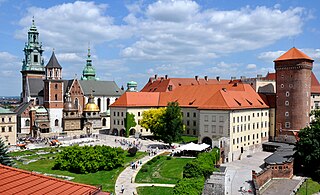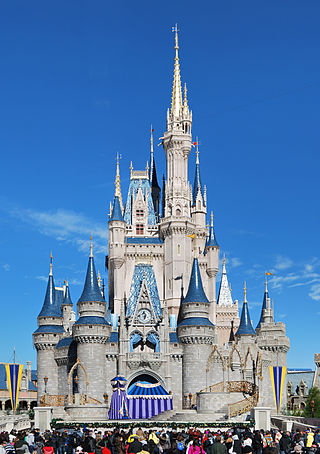
Tourism is travel for pleasure, and the commercial activity of providing and supporting such travel. UN Tourism defines tourism more generally, in terms which go "beyond the common perception of tourism as being limited to holiday activity only", as people "travelling to and staying in places outside their usual environment for not more than one consecutive year for leisure and not less than 24 hours, business and other purposes". Tourism can be domestic or international, and international tourism has both incoming and outgoing implications on a country's balance of payments.

A tourist attraction is a place of interest that tourists visit, typically for its inherent or an exhibited natural or cultural value, historical significance, natural or built beauty, offering leisure and amusement.

Tourism in Japan is a major industry and contributor to the Japanese economy. Foreigners visit Japan to see natural wonders, cities, historic landmarks, and entertainment venues. Japanese people seek similar attractions, as well as recreation and vacation areas. In 2019, Japan attracted 31.88 million international tourists. Japan welcomed 2.78 million visitor arrivals in February 2024, surpassing 2019 levels.

Poland is a part of the global tourism market with constantly increasing number of visitors. Tourism in Poland contributes to the country's overall economy. The most popular cities are Kraków, Warsaw, Wrocław, Gdańsk, Poznań, Szczecin, Lublin, Toruń, Zakopane, the Salt Mine in Wieliczka and the historic site of Auschwitz – a German Nazi concentration camp in Oświęcim. The best recreational destinations include Poland's Masurian Lake District, Baltic Sea coast, Tatra Mountains, Sudetes and Białowieża Forest. Poland's main tourist offers consist of sightseeing within cities, historical monuments, natural monuments, business trips, agrotourism, bicycle touring, qualified tourism, mountain hiking (trekking) and climbing among others.

Terezín is a town in Litoměřice District in the Ústí nad Labem Region of the Czech Republic. It has about 2,800 inhabitants. It is a former military fortress composed of the citadel and adjacent walled garrison town. The town centre is well preserved and is protected by law as an urban monument reservation. Terezin is most infamously the location of the Nazis' notorious Theresienstadt Ghetto.

In the United States, tourism is a large industry that serves millions of international and domestic tourists yearly. Foreigners visit the U.S. to see natural wonders, cities, historic landmarks, and entertainment venues. Americans seek similar attractions, as well as recreation and vacation areas.
Recreational drug tourism is travel for the purpose of obtaining or using drugs for recreational use that are unavailable, illegal or very expensive in one's home jurisdiction. A drug tourist may cross a national border to obtain a drug that is not sold in one's home country, or to obtain an illegal drug that is more available in the visited destination. A drug tourist may also cross a sub-national border to do the same, as in cannabis tourism, or purchase alcohol or tobacco more easily, or at a lower price due to tax laws or other regulations.

Disaster tourism is the practice of visiting locations at which an environmental disaster, either natural or human-made, has occurred. Although a variety of disasters are the subject of subsequent disaster tourism, the most common disaster tourist sites are areas surrounding volcanic eruptions.

Tourism in South Korea and its industry caters to both foreign and domestic tourists. In 2019, 17.5 million foreign tourists visited South Korea, making it the 20th most visited country in the world. Most non-Korean tourists come from other parts of East Asia such as Japan, mainland China, Taiwan, and Hong Kong. The recent popularity of Korean popular culture, often known as the "Korean Wave", in these countries has increased tourist arrivals.

War tourism is recreational travel to active or former war zones for purposes of sightseeing or historical study. The term may be used pejoratively to describe thrill-seeking in dangerous and forbidden places. In 1988, P. J. O'Rourke applied the pejorative meaning to war correspondents.

Atomic tourism or nuclear tourism is a recent form of tourism in which visitors learn about the Atomic Age by traveling to significant sites in atomic history such as nuclear test reactors, museums with nuclear weapon artifacts, delivery vehicles, sites where atomic weapons were detonated, and nuclear power plants.

The New England Holocaust Memorial in Boston, Massachusetts, is dedicated to the Jewish people who were murdered by Nazi Germany during the Holocaust.

Slum tourism, poverty tourism, ghetto tourism or trauma tourism is a type of tourism that involves visiting impoverished areas, or in some cases, areas that were affected by disasters, such as nuclear fallout zones like Chernobyl or Fukushima. Originally focused on the slums and ghettos of London and Manhattan in the 19th century, slum tourism is now prominent in South Africa, India, Brazil, Kenya, Philippines and the United States.

The Auschwitz-Birkenau State Museum is a museum on the site of the Auschwitz concentration camp in Oświęcim, Poland.

The following lists of tourist attractions include tourist attractions in various countries.

Pithiviers internment camp was a concentration camp in Vichy France, located 37 kilometres northeast of Orléans, closely associated with Beaune-la-Rolande internment camp in deporting foreign-born and some French-born Jews between 1941 and 1943 during WWII.

The Royallieu-Compiègne was an internment and deportation camp located in the north of France in the city of Compiègne, open from June 1941 to August 1944. French resistance fighters and Jews were among some of the prisoners held in this camp. It is estimated that around 40,000 people were deported from the Royallieu-Compiègne camp to other camps in the German territory of the time.

Holocaust tourism is tourism to destinations connected with the extermination of Jews during the Holocaust in World War II, including visits to sites of Jewish martyrology such as former Nazi death camps and concentration camps turned into state museums. It belongs to a category of the so-called 'roots tourism' usually across parts of Central Europe, or, more generally, the Western-style dark tourism to sites of death and disaster.

The representation of the Holocaust on social media has been a subject of scholarly inquiry and media attention.



















